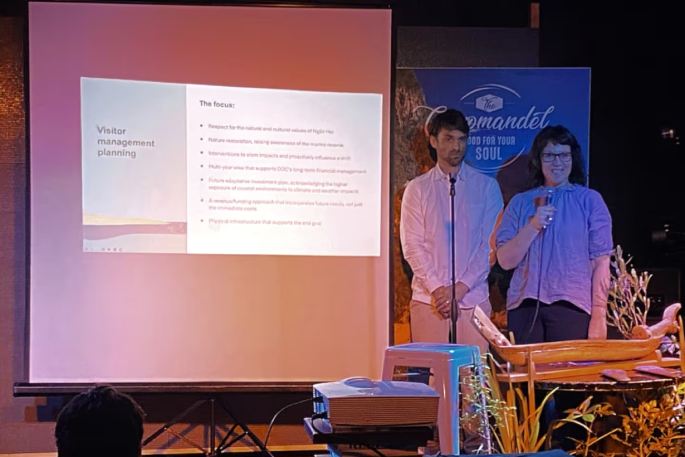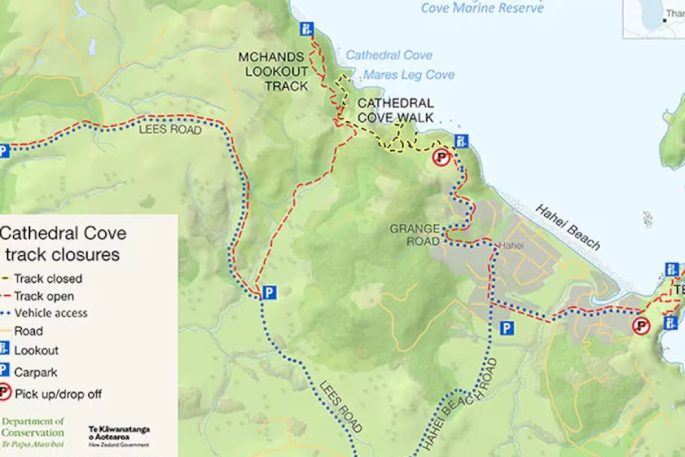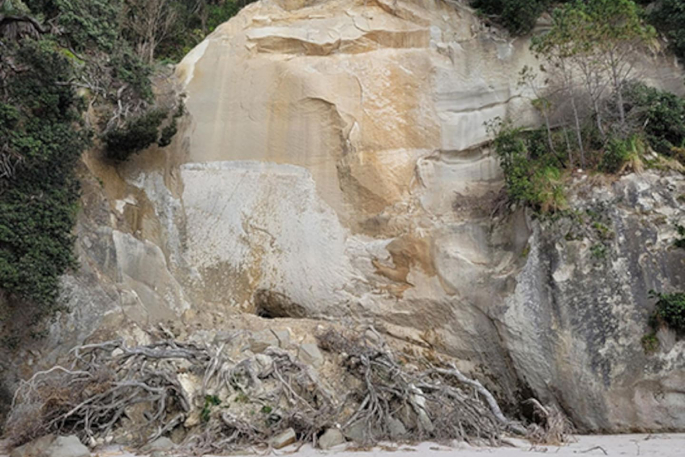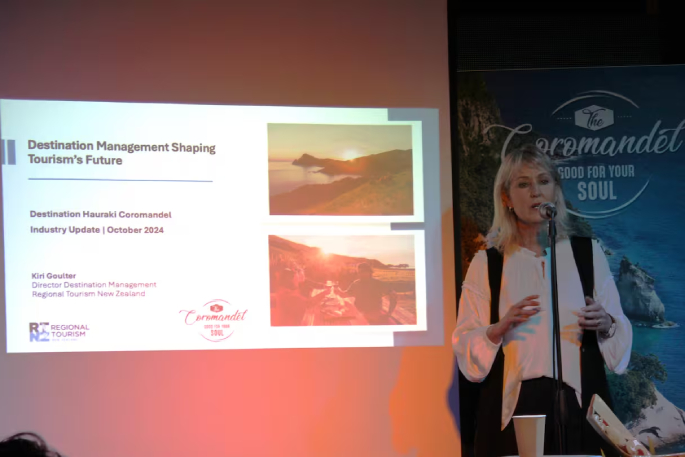Department of Conservation staff have highlighted some of the issues with graffiti, vandalism, unsavoury behaviour, litter and defecation at tourist hot spots including Cathedral Cove and Tongariro Crossing.
DOC Cathedral Cove project managers Michael Sparrow and Tania Short hosted a meeting with tourism sector representatives in Whitianga on October 22 to help them understand topical issues for the industry.
Short said graffiti left by visitors, including carvings that were quite deep, was not only a problem at Cathedral Cove, but in other parts of New Zealand, including Moeraki in the South Island, and around the world.
“It is happening everywhere; there are behaviours that are unsavoury.”
At Cathedral Cove, toileting issues were also causing concern with visitors defecating in the bush and beach areas, consequently taking DoC rangers away from their core responsibilities in order to clean up the mess.
Their concerns follow announcements last week that tourists are hampering contractor efforts to get Cathedral Cove walking access reinstated.
DOC staff and contractors are turning away dozens of visitors every day.
Litter was also an issue as visitors were not prepared, turning up with no sunscreen and dropping items of litter including plastic bottles and nappies.
“A lot of people don’t know what a marine reserve is.”
Short reported up to 50 marine craft a day in the waters surrounding Cathedral Cove during peak times and a reported 10,500 Surf Lifesaving callouts in the past five years.
“Visitors don’t know about rips.”
 DOC Cathedral Cove project managers Michael Sparrow and Tania Short. Photo/ Al Williams
DOC Cathedral Cove project managers Michael Sparrow and Tania Short. Photo/ Al Williams
Tongariro National Park was another area of concern with visitors toileting outside and not wearing appropriate clothes for the weather conditions.
“They just see the Instagram photo.”
Short said, along with Ngāti Hei, DoC would look at better respecting Cathedral Cove.
“With increasing visitor numbers comes more work for rangers; it needs to be a community approach in preparing our visitors.
“We are looking for a long-term sustainable plan, a future adaptive investment plan.
“We have to be agile, we are dealing with climate change, is the track going to last and what does it cost?”
There would be no parking, and no buses allowed on site, as DoC wanted to limit damage to the road.
A range of monitoring methods would be in place to gather data, including cameras, trek counters, visitor surveys and QR codes.
There would also be monitoring of toilet waste to help determine visitor numbers along with ranger observation.
The track to the beach from Grange Rd was being rebuilt along with a clean-up of the site and removal of pest plants.
Four flushing toilets would be installed at the Lees Rd entrance.
“We are aiming to have it open in early December.”
The question had been raised about visitor charges for Cathedral Cove after an entry fee was introduced at Hamilton Gardens.
“Our legislation doesn’t allow for it; watch this space,” Short said.
A tourism operator in the audience asked why no toilets would be installed on the beach at Cathedral Cove as visitors were going to the toilet “all over the beach”.
Short said the conservation minister had said ‘no’ while Ngāti Hei had raised environmental concerns.
Short said DOC had received a number of quotes for permanent access reinstatement to Cathedral Cove and they were “eye watering”.
“So much local effort goes into one site, most of what we are doing is about behavioural change; visitor behaviours are causing us stress.
“We are trying to avoid regulatory measures and seeing what we can do as a community in the early stages.”
Short said it was DOC’s intention to implement measures over summer to manage visitor pressure.
The DoC communications team had developed a digital campaign which would go live in November.
“We need community support.”
There would be some changes when Cathedral Cove reopened with a shuttle and car drop off area at the Grange Rd entrance.

A detailed map of the track closures around Cathedral Cove.
There would be no parking, and no buses allowed on site, as DOC wanted to limit damage to the road.
A range of monitoring methods would be in place to gather data, including cameras, trek counters, visitor surveys and QR codes.
There would also be monitoring of toilet waste to help determine visitor numbers along with ranger observation.
The track to the beach from Grange Rd was being rebuilt along with a clean-up of the site and removal of pest plants.
Four flushing toilets would be installed at the Lees Rd entrance.
“We are aiming to have it open in early December.”
The question had been raised about visitor charges for Cathedral Cove after an entry fee was introduced at Hamilton Gardens.
“Our legislation doesn’t allow for it; watch this space,” Short said.
A tourism operator in the audience asked why no toilets would be installed on the beach at Cathedral Cove as visitors were going to the toilet “all over the beach”.
Short said the conservation minister had said ‘no’ while Ngāti Hei had raised environmental concerns.

A landslide at Cathedral Cove. Photo / Josh Angell, Department of Conservation
Kiri Goulter, Regional Tourism New Zealand destination management director, said regional tourism organisations such as Hauraki-Coromandel were run on the “smell of an oily rag”.
“It’s about partnership with everybody in the broader community sense; it is sad to see DoC reporting poor visitor behaviour.”
Goulter said there had been an increasing desire of people around the world to travel, specifically with the rise of social media, and not always with the right motivations.
“We have heard about ‘over tourism’.”
New Zealand was not without challenges with the types of behaviour the sector was starting to see, she said.
Through surveys, New Zealanders had changed perceptions of tourism between 2015 and 2019, she said, as an increasing number were concerned about environmental damage, infrastructure pressures and bad behaviour in key visitor spots.
“Many costs are not accounted for, rising house and land prices have been driven by tourism.
“As tourism grows, visitors bring pressures; destinations need our attention and focus.”
Goulter said local and central government investment in tourism was “not a lot”.
“We need to be smart with what we do; we need to work as a community, everybody is involved.”
That would involve partnership, additional funding and destination management plans, she said.
“We need to take a holistic view in how we prepare for the future.
“What is the future you want from tourism and how do we involve everyone?”
“Destination management protects the place.”
She said the funding mechanism for tourism had been in place for 30 years and needed to be reviewed.
“The model we are currently working with needs rethinking if we are going to be set for the future.”
Destination Hauraki Coromandel general manager Hadley Dryden said there was a move to a carbon neutral visitor experience.
“In the travel industry we are asking people to consume experiences rather than things; carbon, waste and predator free businesses delivering a sustainable experience.
“When we developed a travel application, we picked a company that is involved in regenerative work; we are carbon-zero.”



0 comments
Leave a Comment
You must be logged in to make a comment.